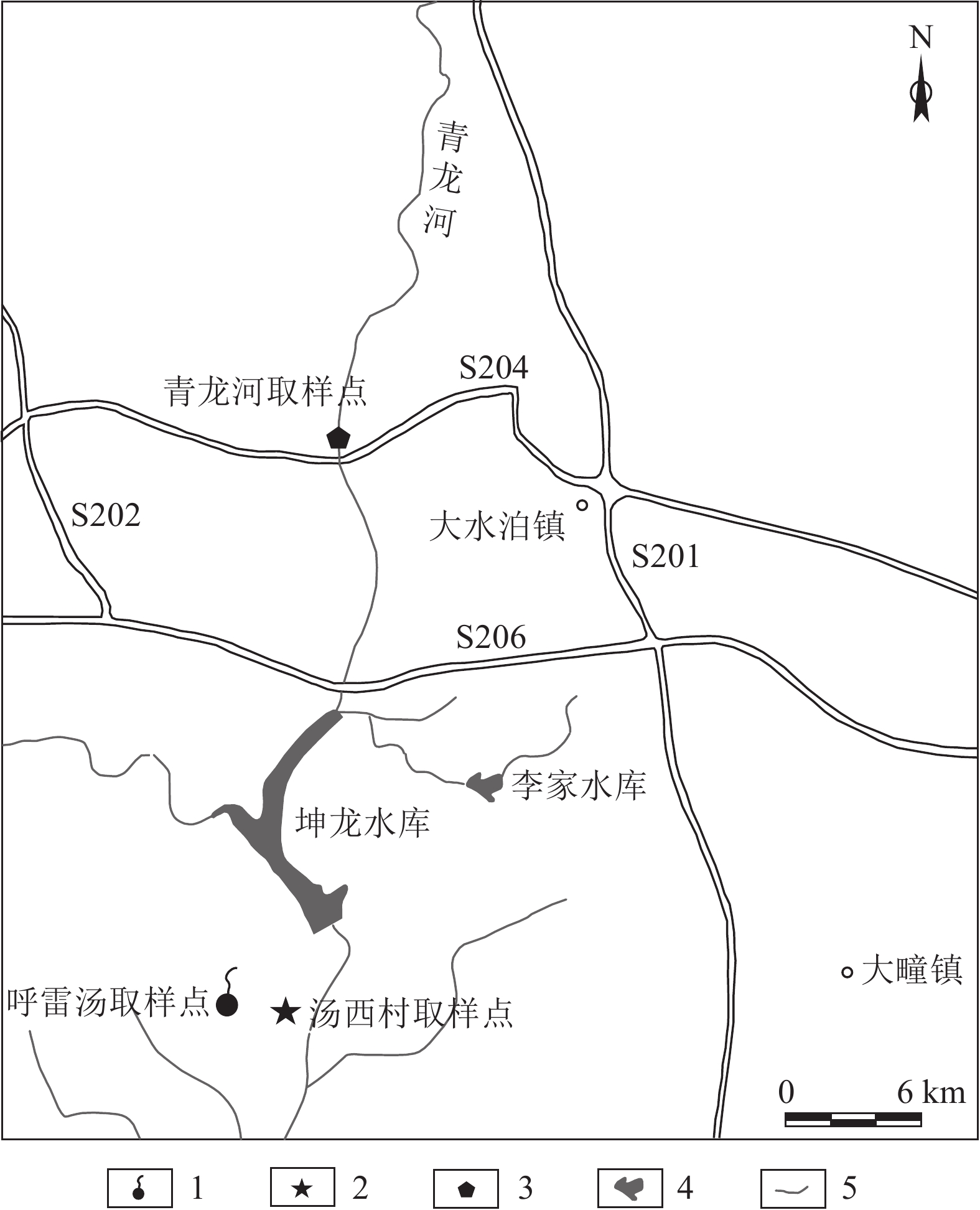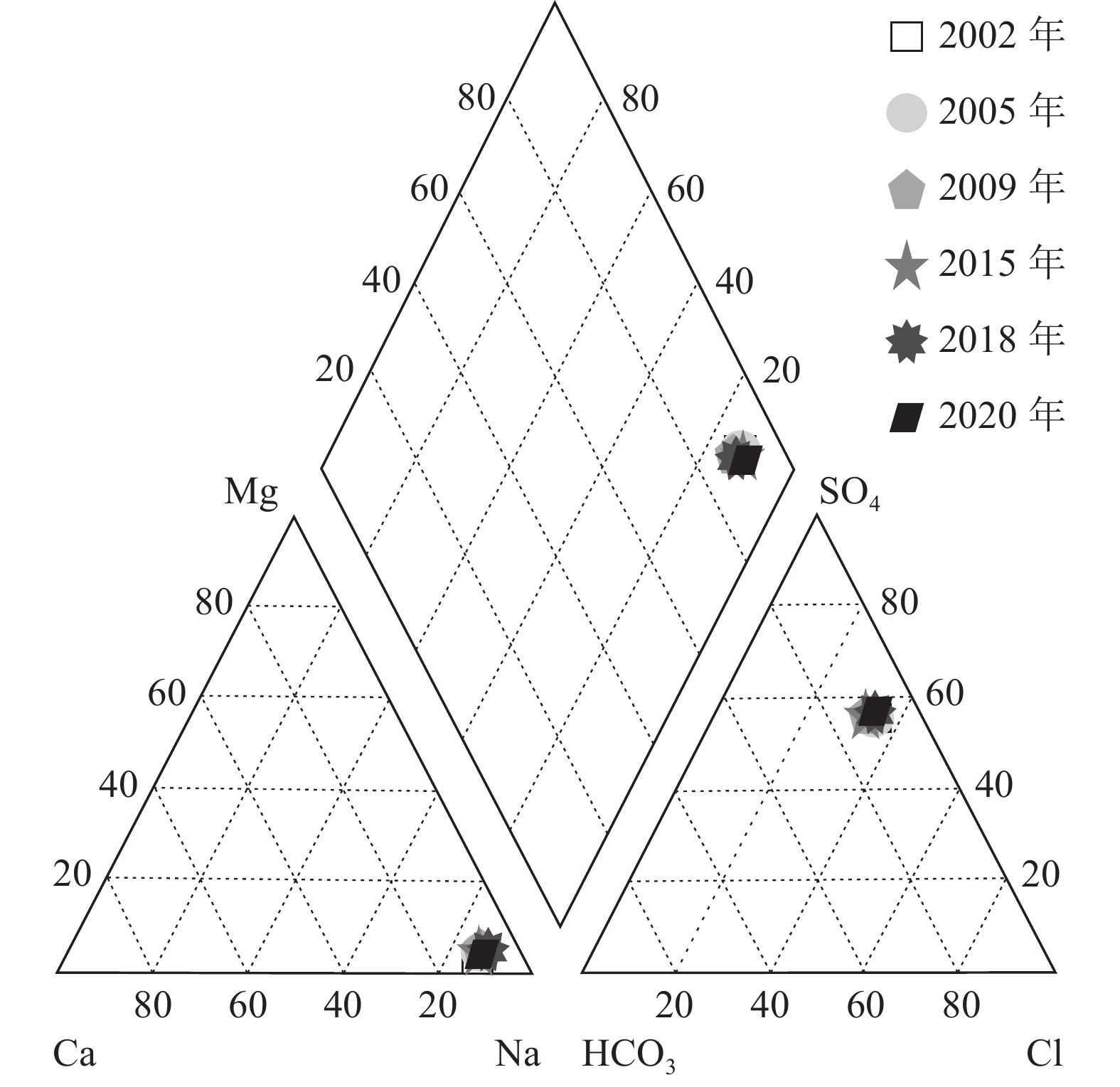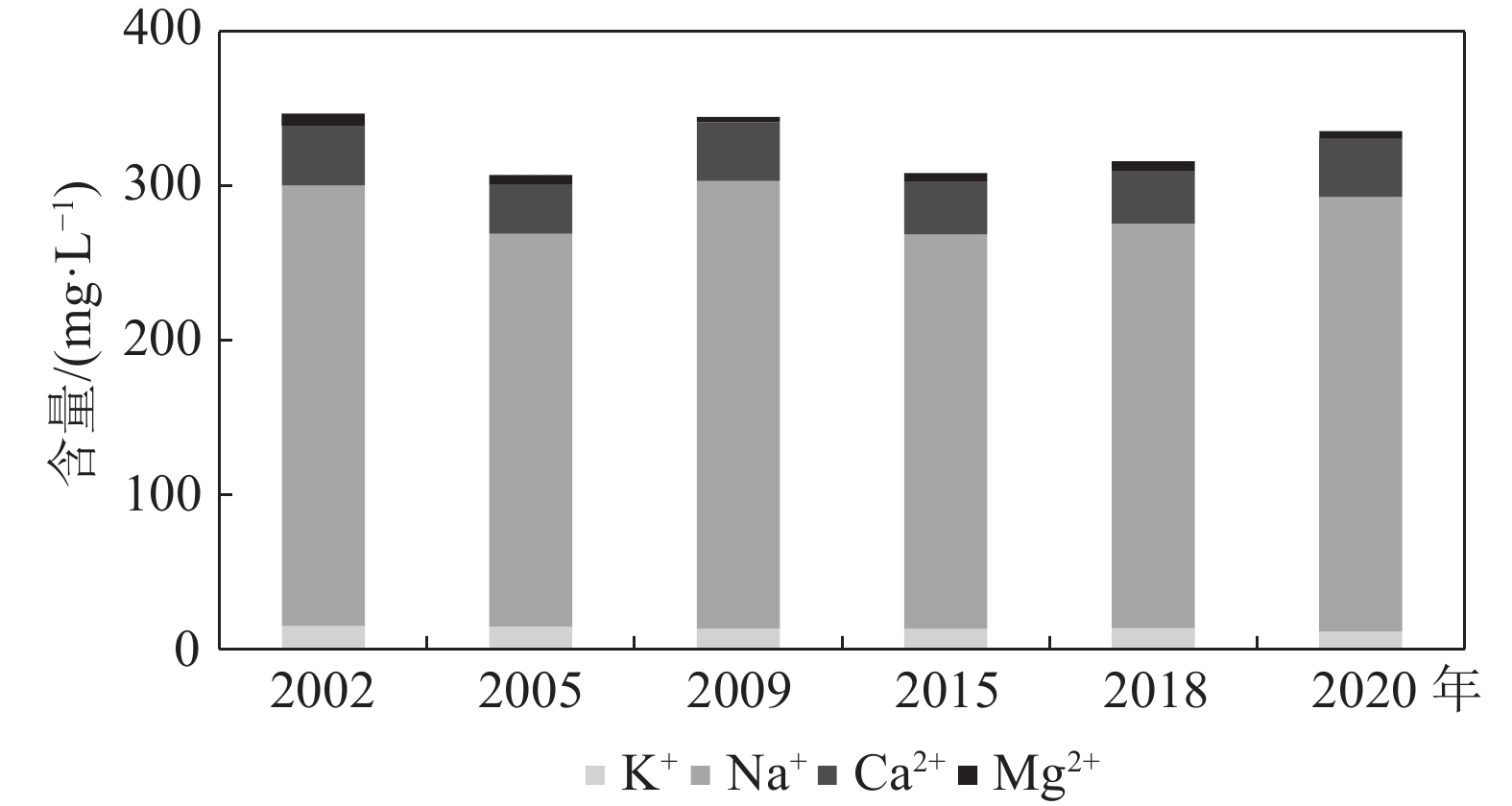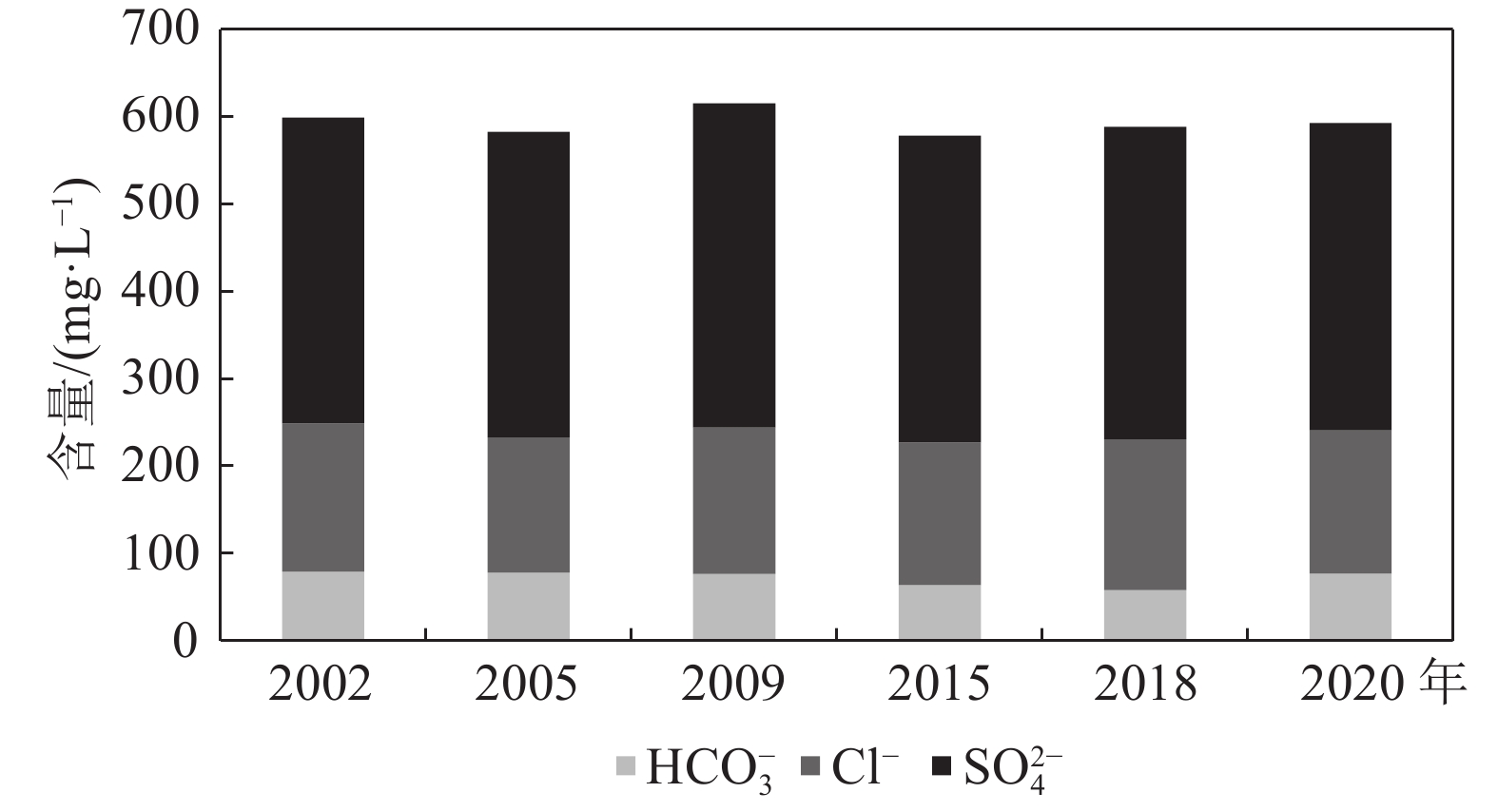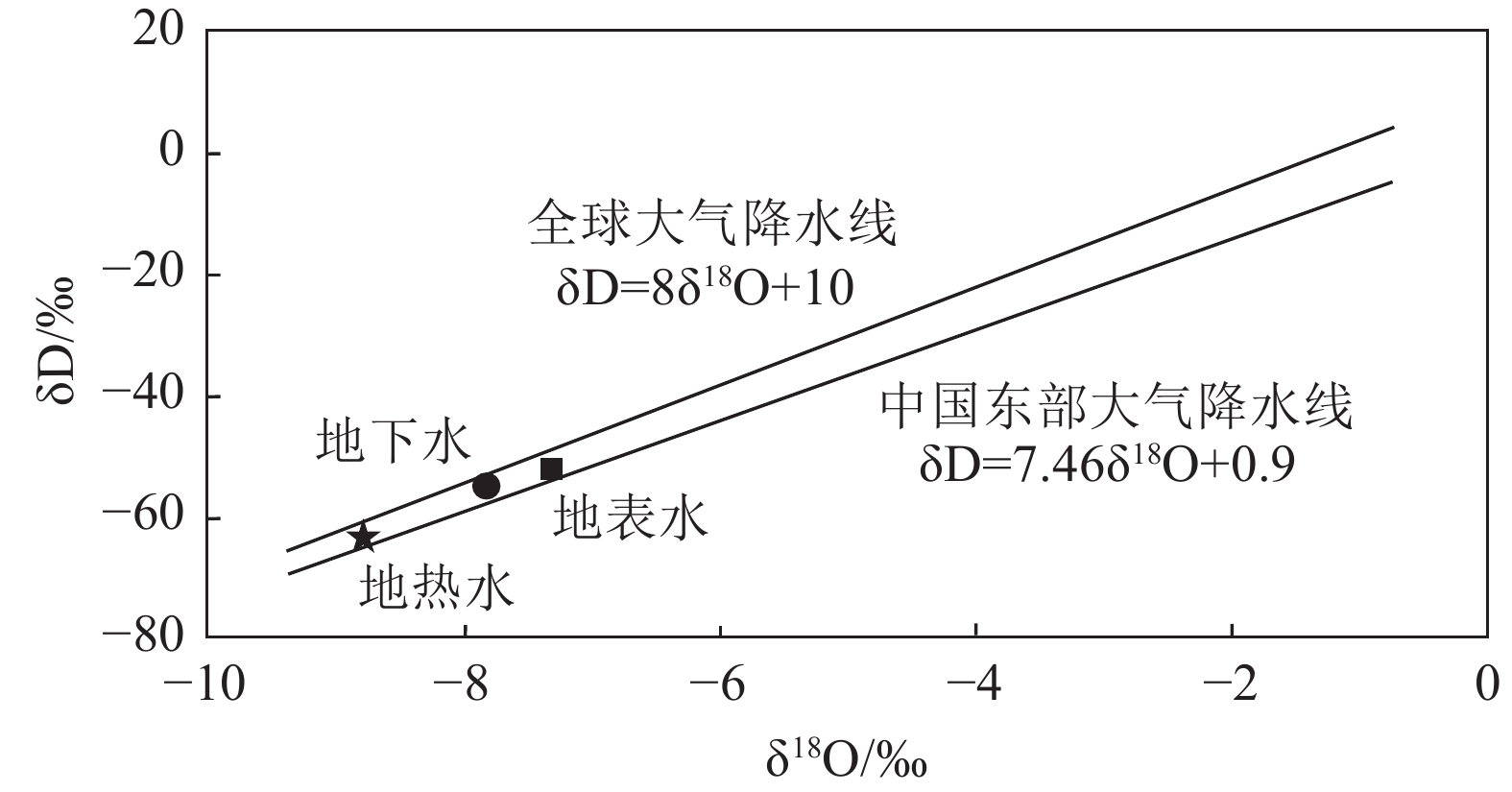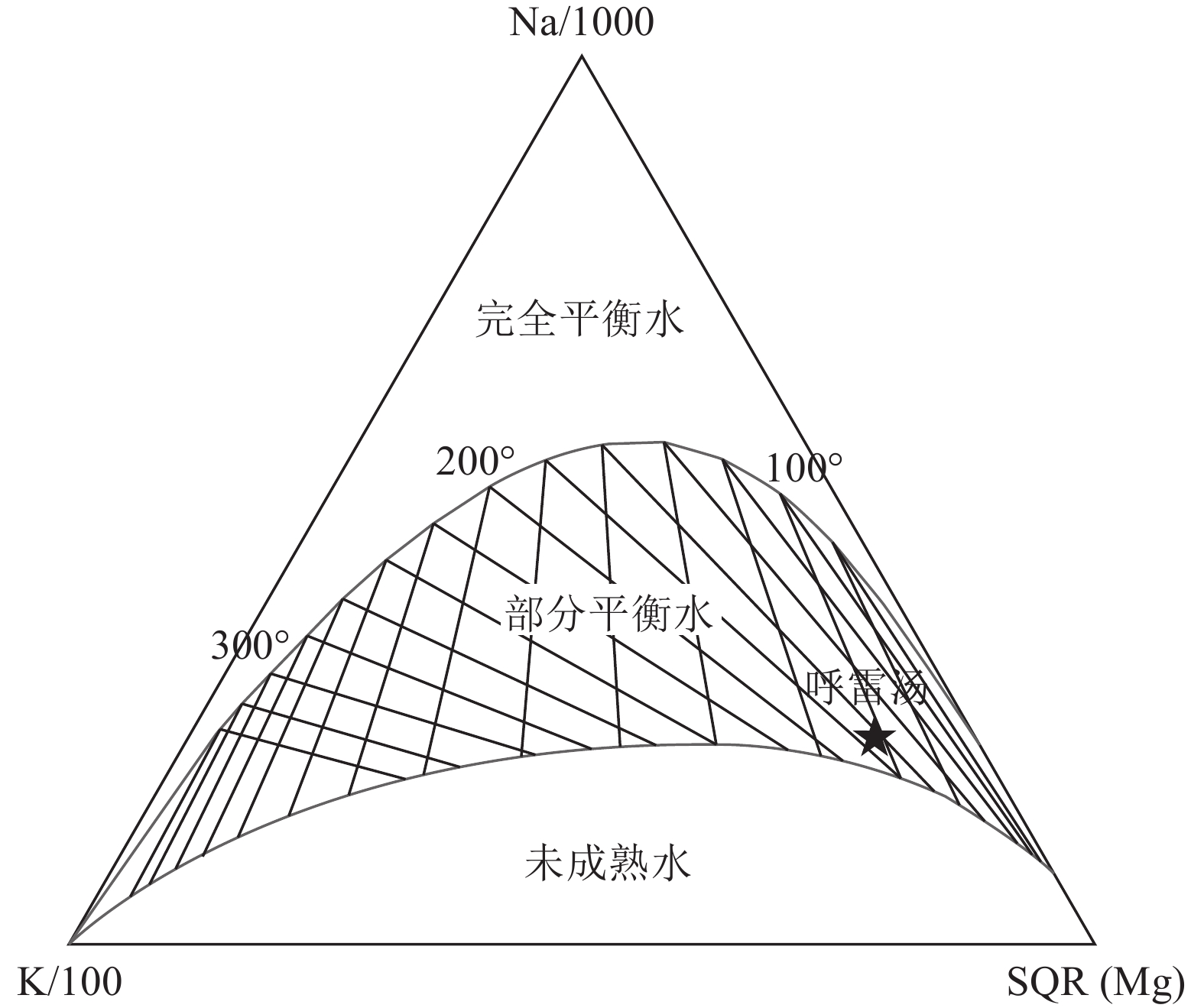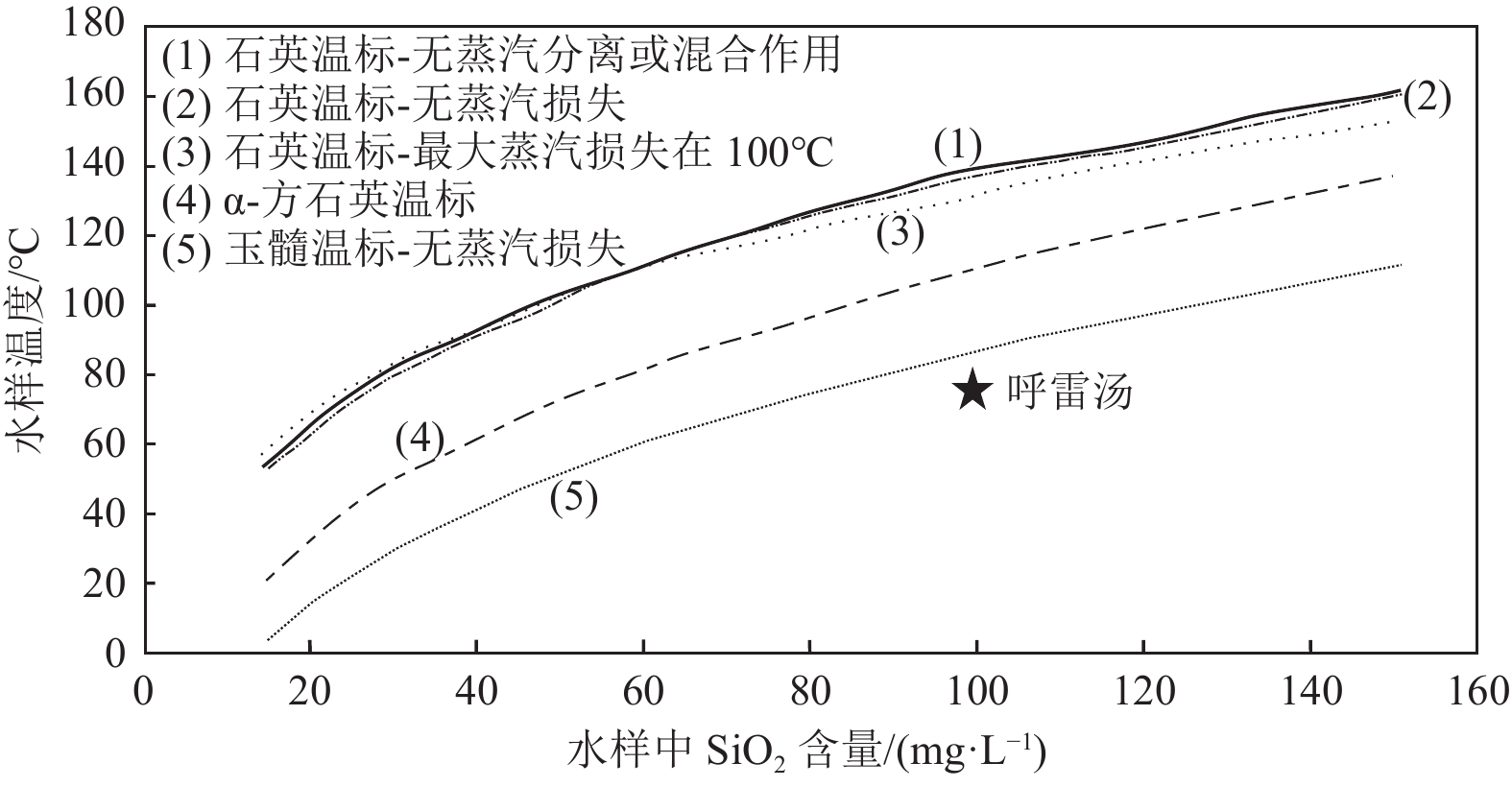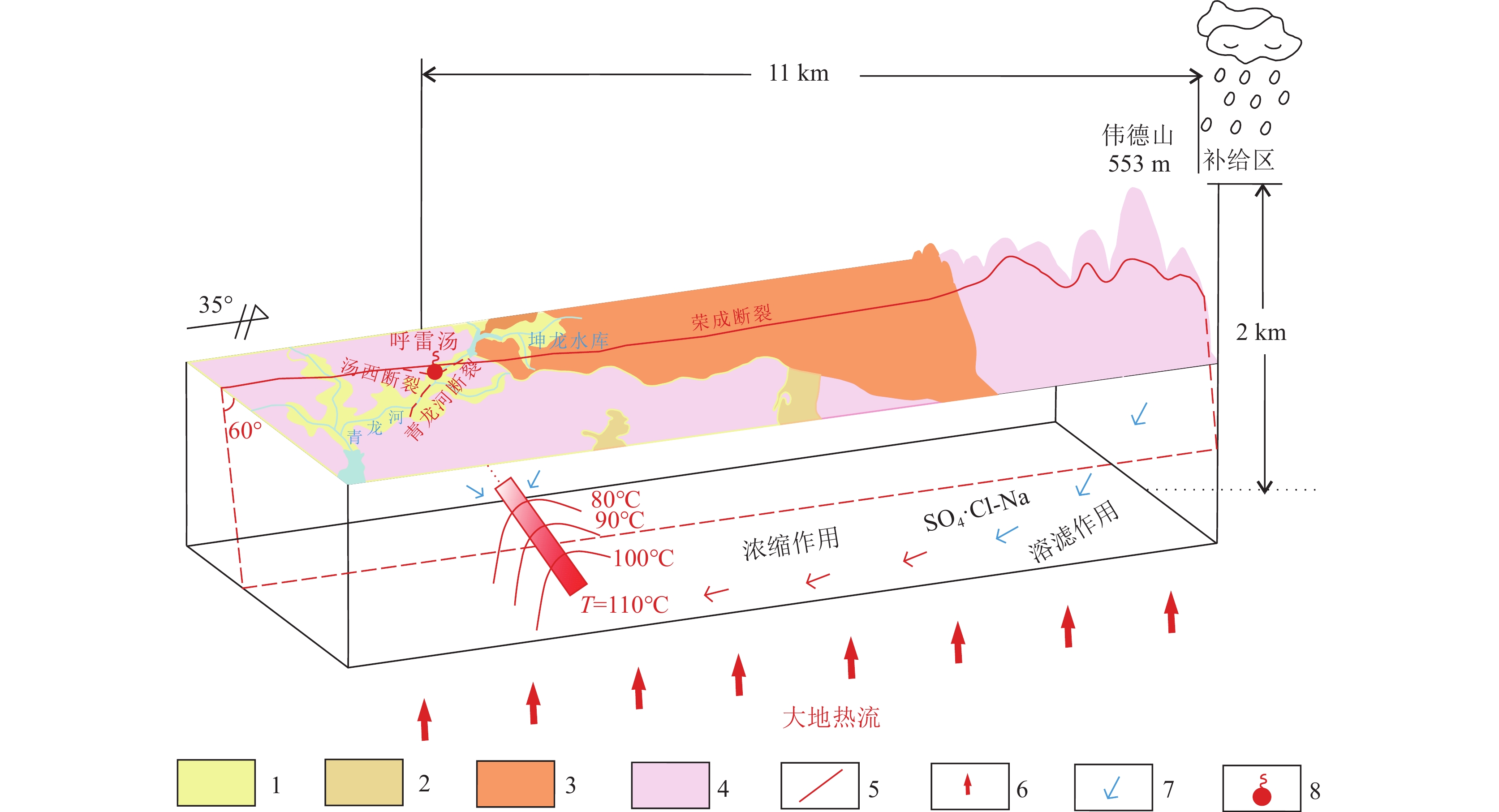Study on the hydrochemistry, genesis and development potential of Huleitang geothermal water in Weihai City, Shandong Province
-
摘要:
山东省储藏着丰富的中低温地热资源,呼雷汤是省内唯一可自流的温泉,其成因模式不明一定程度上影响了地热资源的有效利用。为查明呼雷汤成因模式,综合运用地面调查、物探、样品分析测试等方法进行分析研究。结果表明,呼雷汤的形成在区域上受荣成断裂控制,局部受青龙河断裂和汤西断裂控制,其补给水源为大气降水,热源为地热增温,估算补给高程为436~559 m、热储温度为109~118℃、循环深度为2159~2368 m。综上所述,呼雷汤的成因模式为:在伟德山山区获得大气降水补给后,沿荣成断裂下渗参与到地下水循环系统中,在径流过程中通过吸收围岩中的热量发生溶滤作用和水−岩相互作用,在地下2 km左右形成温度约110℃的SO4•Cl-Na型水;由于温度和压力的升高,地下热水沿构造裂隙向地表流动,在上涌过程中混入部分地下水,温度降低,最后在青龙河断裂和汤西断裂的交会处、静水压力最小的部位出露成泉。通过地热水开发利用潜力评价分析可知,地热水可用于理疗、洗浴和供暖,每年可供1840个床位理疗、46万人洗浴、908×104 m2面积供暖。
Abstract:Abundant medium and low temperature geothermal resources are stored in Shandong Province. Huleitang spring, located in Weihai of Shandong province, is a unique artesian spring in this area. Due to some unidentified genesis of Huleitang spring, the effective utilization of the geothermal resources cannot implement to a certain extent. In order to find out the genetic model of the Huleitang spring, this study comprehensively uses ground investigation, geophysical prospecting and sample analysis to analyze and study. The results show that the formation of the Hulaitang spring is controlled by Rongcheng fault in the region, and by Qinglonghe fault and Tangxi fault in the local area. Its source recharges from atmospheric precipitation, and its heat source is geothermal heating. The estimated recharge elevation is 436~559 m, the calculated geothermal reservoir temperature is 109~118℃, and the calculated circulation depth is 2159~2368 m. In summary, the genetic model of the Hulaitang spring is as follows: recharges from precipitation of Weide mountain area, infiltrates down along the Rongcheng fault and participates in the groundwater circulation system. In the process of runoff, the water type of SO4•Cl-Na was formed with the temperature of 110°C about 2 km underground by absorbing the heat of surrounding rock, dissolving and filtering, and water-rock interaction. Due to the increase of temperature and pressure, the hot water flows to the surface along the structural fractures. In the upwelling process, it mixes with some cold water, and the temperature decreases. However, it emerges as a free-flow spring at the intersection of Qinglonghe fault and Tangxi fault where is distributed with the minimum hydrostatic pressure. According to the evaluation and analysis of geothermal water development and utilization potential, geothermal water of Hulaitang spring area can be used for physiotherapy, bathing and heating, which can provide 1840 beds for physiotherapy, 460,000 people for bathing and 9.08 million m2 for heating each year.
-
Key words:
- Huleitang /
- hydrochemical characteristics /
- genetic model /
- development potential /
- Shandong
-

-
图 3 呼雷汤Piper三线图(据Piper,1944修改)
Figure 3.
表 1 呼雷汤水化学测试数据
Table 1. Chemical analyses of Huleitang hot spring
mg/L 分析项目 2002年地热水 2005年地热水 2009年地热水 2015年地热水 2018年地热水 2020年地热水 2020年地下水 2020年地表水 pH 8.2 8.0 8.4 8.04 8.36 8.16 7.31 7.33 K+ 15.09 14.61 13.25 12.93 13.56 11.6 2.42 3.13 Na+ 285.4 254.5 290.0 255.90 262.10 281.4 36.62 31.81 Ca2+ 38.8 32.03 38.16 34.31 34.33 38.01 66.86 67.17 Mg2+ 0.98 0.49 <0.30 0.57 0.53 0.68 25.61 22.97 HCO3− 79.33 78.23 76.57 63.86 58.05 76.8 115.8 176.2 Cl− 169.7 154.56 167.72 163.2 172.78 163.9 58.12 70.03 SO42− 350 350 371.18 351.3 357.67 352 70.52 72.16 F− / / 10.00 7.38 5.89 8.72 0.33 0.29 可溶SiO2 100 98 110 113.4 108.53 100 30.33 18.51 偏硅酸 130 127.40 143 147.42 141.09 130 39.43 24.06 Li / / 0.31 0.29 0.3 0.434 <0.005 <0.005 Sr / / 2.62 2.22 2.2 2.458 0.548 0.606 TDS 1065.94 948.97 1077.48 982.91 985.25 1039 528.6 503.1 注:2020年为实测数据,测试单位为原国土资源部地下水矿泉水及环境监测中心,其余为收集数据 表 2 水样δD和δ18O测试数据
Table 2. Data of δD and δ18O in water samples
样品类型 δD/‰ δ18O/‰ 呼雷汤(地热水) −64 −8.8 汤西村(地下水) −54 −7.8 青龙河(地表水) −52 −7.3 注:取样时间为2020年,测试单位为原国土资源部地下水矿泉水及环境监测中心 表 3 呼雷汤补给高程
Table 3. Estimated recharge altitude of Huleitang
温泉名称 取样点高程/m δD/‰ δ18O/‰ 补给高程/m 公式(4)(δD) 公式(4)(δ18O) 呼雷汤 15.48 −64 −8.8 436 559 表 4 呼雷汤的循环深度
Table 4. Estimated circulation depth of Huleitangg
温泉名称 G/m/℃ tZ/℃ t0/℃ Z0/m Z/m 呼雷汤 22.7 109~118 15 20 2159~2368 表 5 地热水化学成分特征值对比
Table 5. Comparison of characteristic values of geothermal water chemical composition
成分 国家标准(GB11615—2010)特征值 地热水中含量/(mg·L−1) 评价结果 有医疗价值浓度 矿水浓度 命名矿水浓度 氟 1 2 2 5.89~10.00 氟水 锶 10 10 10 2.2~2.62 小于 锂 1 1 5 0.29~0.434 小于 偏硅酸 25 25 50 98~113.4 硅水 氡/(Bq·L−1) 37 47.14 129.5 2.45 小于 温度/℃ ≥34 — — 66 有医疗价值 矿化度 <1000 — — 948.97~1077.48 淡水—微咸水 -
[1] Craig H. 1961a. Isotopic Variation in Meteoric Waters[J]. Science, 133(3465): 1702−1703.
[2] Craig H. 1961b. Standard for reporting concentrations of deuterium and oxygen−18 in natural water[J]. Science, 133: 1833-1834.
[3] Piper A M. 1944. A graphic procedure in the geochemical interpretation of water analyses[J]. Transaction, American Geophysical Union, 25: 914-923.
[4] Rybach L, Muffler L J P. 1986. Geothermal systems principles and case histories[M]. 北京大学地质学系地热研究室译. 地热系统原理和典型地热系统分析. 北京: 地质出版社: 1− 277.
[5] 程裕淇. 2004. 大别―苏鲁造山带地质图[M]. 北京: 地质出版社: 1−76.
[6] 杜桂林, 曹文海, 翟滨. 2012. 威海市宝泉汤温泉成因及其对断裂和地震活动性的影响[J]. 海洋地质与第四纪地质, 32(5): 67−71.
[7] 郭忠杰, 王锦国, 陈舟, 等. 2015.云南省鹤庆西山温水龙潭温泉成因机制探讨[J]. 工程勘察, (5): 43−48.
[8] 高宗军, 孙智杰, 杨永红, 等. 2019. 山东省地热水水化学研究及赋存特征[J]. 科学技术与工程, 19(20): 85−90.
[9] 贾东. 1993. 山东地体构造及其拼贴运动学研究[M]. 南京: 南京大学出版社: 1−100.
[10] 金秉福, 张云吉, 栾光忠. 1999. 胶东半岛地热资源的特征[J]. 烟台师范学院学报(自然科学版), 15(4): 297−301.
[11] 金秉福, 张云吉, 栾光忠. 2000. 胶东半岛温泉的地热特征[J]. 水文地质工程地质, 27(5): 31−37.
[12] 刘春雷, 李亚松, 洪炳义, 等. 2023. 福建盐田海水补给型地热系统地球化学特征及其成因[J]. 水文地质工程地质, 50(1): 158−167.
[13] 栾光忠, 刘红军, 刘冬雁, 等. 2002. 山东半岛温泉的地热属性及其特征[J]. 地球学报, 23(1): 79−84.
[14] 龙汨, 周训, 李婷, 等. 2014. 北京延庆县松山温泉的特征与成因[J]. 现代地质, 28(5): 1053−1060.
[15] 李曙光, 黄方, 李晖. 2001. 大别−苏鲁造山带碰撞后的岩石圈拆离[J]. 科学通报, 46(17): 1487−1491.
[16] 李学伦, 孙效功, 王永红. 1997a. 山东半岛温泉的分布规律与成因[J]. 青岛海洋大学学报, 27(3): 389−396.
[17] 李学伦, 刘保华, 孙效功, 等. 1997b. 山东半岛硅热流值与区域地质条件的关系[J]. 青岛海洋大学学报, 27(1): 75−83.
[18] 山东省地质矿产局. 1995. 中华人民共和国区域地质调查报告(威海、羊亭等九幅, 1∶5万)[M]. 北京: 地质出版社: 1−564.
[19] 史猛, 康凤新, 张杰, 等. 2019. 胶东半岛中低温对流型地热资源赋存机理及找矿模型[J]. 地质论评, 65(5): 1276−1287.
[20] 拓明明, 周训, 郭娟, 等. 2018. 重庆温泉及地下热水的分布及成因[J]. 水文地质与工程地质, 45(1): 165−172.
[21] 汪集旸, 熊亮萍, 庞忠和. 1993. 中低温对流型地热系统[M]. 北京: 科学出版社: 55−56.
[22] 江海洋, 王树星, 刘连, 等. 2018. 沂沭断裂带临沂段地热资源水化学及环境同位素特[J]. 上海国土资源, 39(4): 90−94.
[23] 王贵玲, 张薇, 梁继运, 等. 2017a. 中国地热资源潜力评价[J]. 地球学报, 38(4): 449−459.
[24] 王贵玲, 张薇, 蔺文静, 等. 2017b. 京津冀地区地热资源成藏模式与潜力研究[J]. 中国地质, 44(6): 1074−1085.
[25] 王婉丽, 王贵玲, 朱喜, 等. 2017. 中国省会城市浅层地热能开发利用条件及潜力评价[J]. 中国地质, 44(6): 1062−1073.
[26] 王恒纯. 1991. 同位素水文地质概论[M]. 北京: 地质出版社: 37−57.
[27] 王洁清, 周训, 李晓露, 等. 2017. 云南兰坪盆地羊吃蜜温泉水化学特征与成因分析[J]. 现代地质, 31(4): 822−831.
[28] 王晓翠, 孙海龙, 袁星芳. 2022. 胶东典型花岗岩热储地下热水水化学特征及热储研究[J]. 水文地质工程地质, 49(5): 186−194.
[29] 王莹, 周训, 于湲, 等. 2007. 应用地热温标估算地下热储温度[J]. 现代地质, 21(4): 605−612. doi: 10.3969/j.issn.1000-8527.2007.04.003
[30] 王聿军, 马祥县, 单伟. 2011. 威海市洪水岚汤温泉地热地质特征及成因机制探讨[J]. 山东国土资源, 27(2): 16−19.
[31] 威海市统计局. 2020. 国家统计局威海调查队. 威海市统计年鉴[M]. 北京: 地质出版社: 1−512.
[32] 许鹏, 谭红兵, 张燕飞, 等. 2018. 特提斯喜马拉雅带地热水化学特征与物源机制[J]. 中国地质, 45(6): 1142−1154.
[33] 谢娜, 喻生波, 丁宏伟, 等. 2020. 甘肃省地热资源赋存特征及潜力评价[J]. 中国地质, 47(6): 1804−1812.
[34] 余卓伟. 2016. 胶东东部地区早白垩世构造−岩浆时空演化、控金性及大地构造意义[D]. 中国地质大学(北京)硕士学位论文.
[35] 余鸣潇. 2019. 云南省临沧地区部分温泉水化学同位素特征及成因研究[D]. 中国地质大学(北京) 硕士学位论文.
[36] 袁星芳, 王敬, 霍光, 等. 2020. 胶东半岛洪水岚汤温泉水化学特征与成因分析[J]. 地质与勘探, 56(2): 427−437.
[37] 袁星芳, 邢立亭, 贾群龙, 等. 2023. 威海市七里汤地热田特征及其成因机制[J]. 西北地质, 56(6): 209−218.
[38] 张涛. 2011. 胶东温泉地热水水化学及同位素特征研究[J]. 山东国土资源, 27(12): 11−16.
[39] 张田, 张岳桥. 2007. 胶东半岛中生代侵入岩岩浆活动序列及其构造制约[J]. 高校地质学报, 13(2): 323−336.
[40] 张彧齐, 周训, 刘海生, 等. 2018. 云南兰坪−思茅盆地红层中温泉和盐泉的水文地质特征[J]. 水文地质工程地质, 45(3): 40−48.
[41] 赵辉, 殷涛, 史猛, 等. 2019. 胶东地热田地热流体的补径排特征——以招远东汤地热田为例[J]. 山东国土资源, 35(1): 62−70.
[42] 中华人民共和国国家卫生和计划生育委员会,国家食品药品监督管理总局. 2016.GB 8538—2016. 食品安全国家标准饮用天然矿泉水检验方法[S].
[43] 中华人民共和国地质矿产部. 1993. DZ/T 0064—1993. 地下水质检验方法[S].
[44] 中华人民共和国工业和信息化部. 2015. JCZX-BZ-002—2015. 水中氢氧同位素光谱法测定[S].
[45] 环境保护部. 2017. HJ 826—2017. 水质 阴离子表面活性剂的测定流动注射——亚甲基蓝分光光度法[S].
[46] 中华人民共和国住房和城乡建设部.2019.GB 50015—2019.建筑给水排水设计标准[S].
[47] 中华人民共和国住房和城乡建设部. 2002.GB/T 50331—2002.城市居民生活用水量标准[S].
[48] 中华人民共和国住房和城乡建设部. 2015.GB 50189—2015.公共建筑节能设计标准[S].
[49] 周训. 2010. 地下水科学专论[M]. 北京: 地质出版社: 32−74.
-



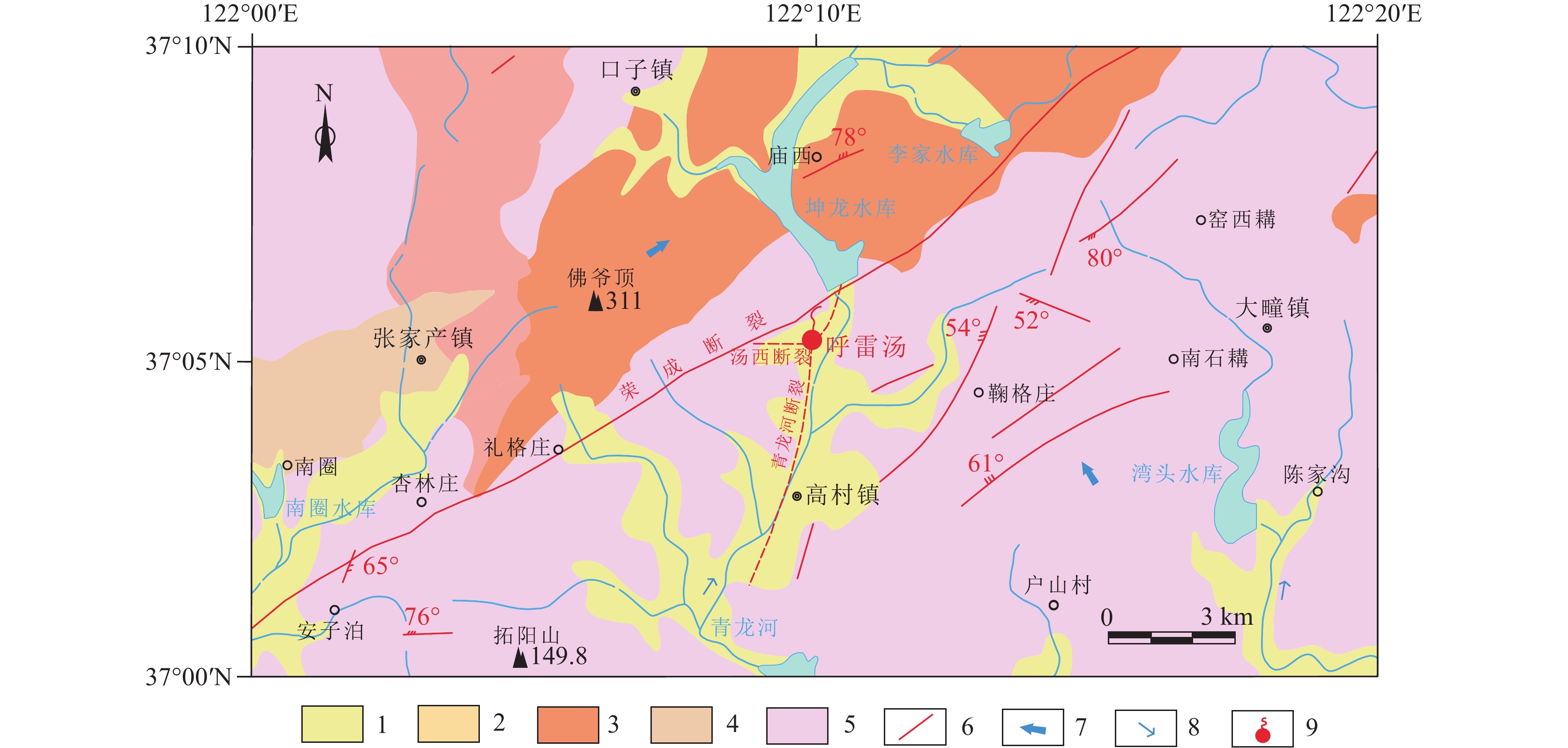
 下载:
下载:
